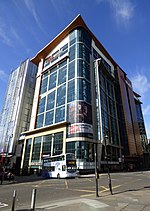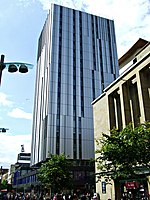Green's Playhouse
1973 disestablishments in ScotlandCinemas in GlasgowDemolished buildings and structures in ScotlandEngvarB from February 2016Event venues established in 1927 ... and 4 more
Former buildings and structures in ScotlandFormer music venues in ScotlandHistory of GlasgowMusic venues in Glasgow
Green's Playhouse was an entertainment complex comprising a cinema, ballroom, tea rooms and other facilities. The Playhouse was at 126 Renfield Street, Glasgow, Scotland, commissioned by George Green Ltd, designed by the architect John Fairweather, and built by the Cinema Building Company. Opened in 1927, the Playhouse operated until the 1970s, a decline in audience numbers in the 1960s necessitated diversification as a music venue until closure in 1973. The building continued in use as the Apollo, after being acquired by Unicorn Leisure on a lease-holding arrangement, until final closure in 1985, with subsequent demolition in 1987.
Excerpt from the Wikipedia article Green's Playhouse (License: CC BY-SA 3.0, Authors).Green's Playhouse
West Regent Street, Glasgow Blythswood Hill
Geographical coordinates (GPS) Address Nearby Places Show on map
Geographical coordinates (GPS)
| Latitude | Longitude |
|---|---|
| N 55.863 ° | E -4.256 ° |
Address
West Regent Street
West Regent Street
G1 2SH Glasgow, Blythswood Hill
Scotland, United Kingdom
Open on Google Maps








